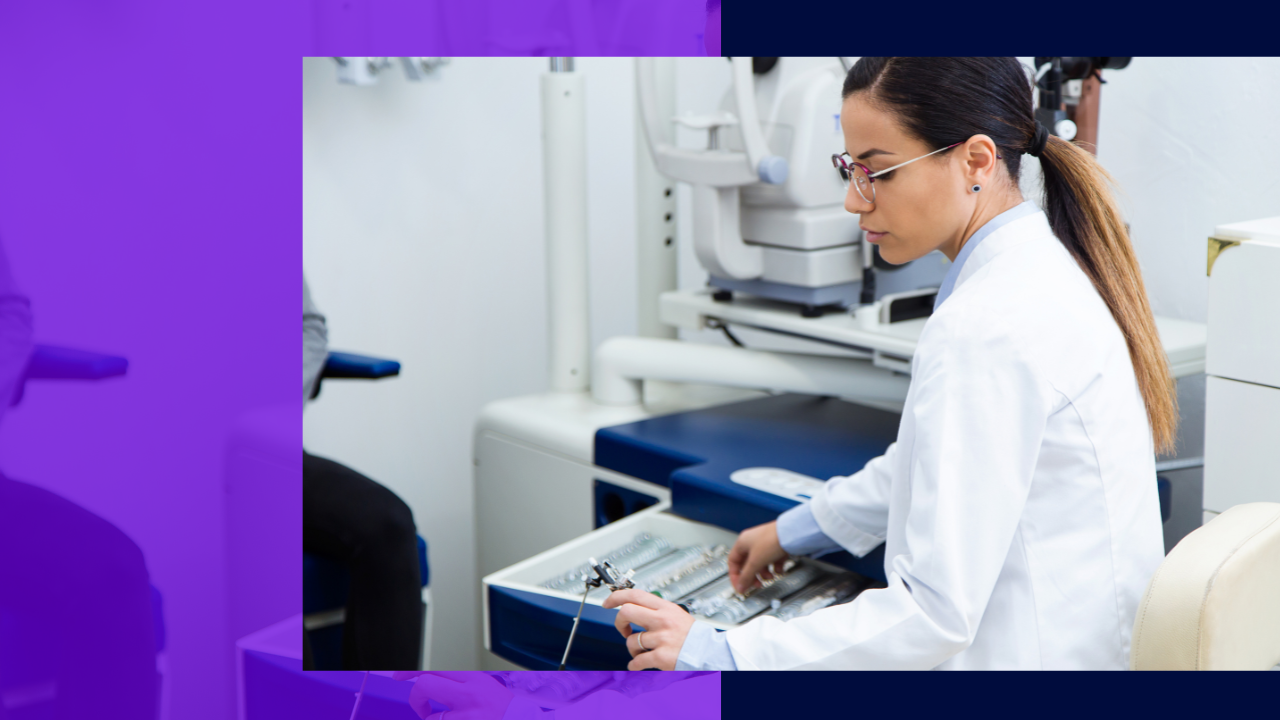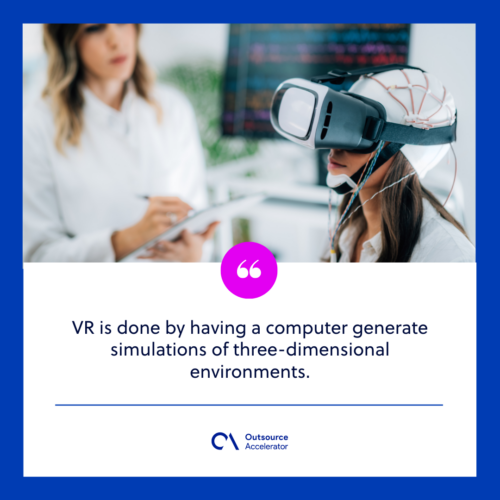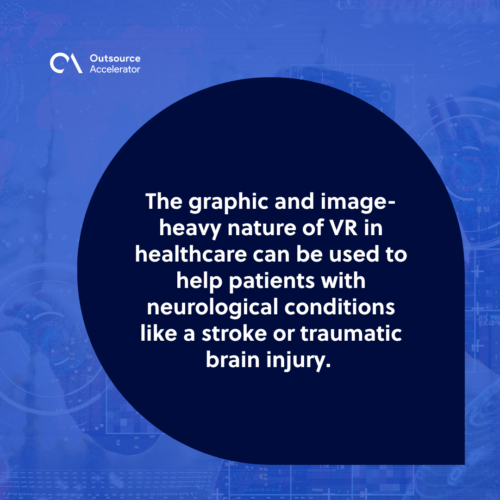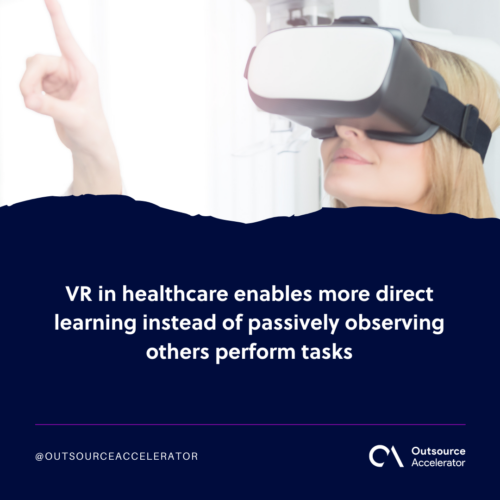10 applications of VR in healthcare

Virtual reality (VR) has the potential to become one of the most powerful tools in healthcare, and it’s already making an impact on how people approach their health.
The use of VR in healthcare is still in its infancy,[1] but there are many ways for it to be used to improve patient care and help doctors make better diagnoses.
How does VR in healthcare work?
VR is done by having a computer generate simulations of three-dimensional environments. VR allows people to interact with these simulations in a seemingly real or physical way using special equipment.[2]
The objective of VR is immersion, to create a feeling of presence through realistic images even though nothing is actually there.
VR in healthcare aims to provide these immersive experiences for patients. The goal is to make the experience feel authentic enough to trigger the brain’s response as if it were real. The more realistic the graphics, the better VR in healthcare will work.

Applications of VR in healthcare
VR in healthcare has numerous applications; some are already in use, while others are still being studied.
Here are ten of the most promising ways that VR in healthcare can be used:
1. Medical education
The use of VR in healthcare has recently increased dramatically with the advent of affordable, high-quality hardware and software.
Virtual reality can be used to teach medical students about anatomy, physiology, biochemistry, and other subjects. This method will be a huge step up from books and instructional videos.
VR in healthcare can teach students without having to conduct experiments on live animals or spend time observing procedures.
Medical students can practice performing procedures on simulated patients that can be programmed with specific medical conditions.
2. Telemedicine and conferencing
Similar to how communication platforms like Zoom and Google Meet allow virtual correspondence, VR in healthcare provides telemedicine and health conferencing avenues.
Telemedicine is medical diagnosis over long distances. Via virtual reality, patients can be connected to and receive treatment from specialists who might not be located near them.
This application of VR in healthcare would be particularly helpful for patients in rural areas.
Medical professionals can also use virtual reality to collaborate and share data with other doctors in virtual environments.
3. Surgery
VR in healthcare can be used to improve the way surgeons train their skills. This commonly means using simulations to practice before the real operations.
The use of VR in healthcare surgery has increased significantly over the years due to its ability to provide an immersive, safe experience for both surgeons and patients.
4. Physical therapy
Physical therapists can use virtual reality exercises to help patients recover from orthopedic (relating to bones and muscles) surgeries.
Patients are exposed to a simulated environment where they have to perform certain movements while therapists observe and guide them.
This helps them improve their motor skills and overall recovery time. It also reduces the possibility of re-injury because physical therapists can make necessary adjustments more easily.
5. Rehabilitation
The graphic and image-heavy nature of VR in healthcare can be used to help patients with neurological conditions like a stroke or traumatic brain injury.
These types of injuries usually cause movement impairment. The VR can replicate scenarios the injured person can use to help regain mobility. This setting allows them to practice without risking further injury.

6. Pain management
VR in healthcare has also been used as a form of pain management. While it hasn’t eliminated the need for painkillers or other medications, virtual reality drastically reduces the time it takes for recovery.
The idea is that the brain can be tricked into thinking an injury is less painful than it actually is. The patient’s body then responds by releasing chemicals that help the pain relief process.
When used in conjunction with traditional pain relief, a hospital stay can become quite pleasant.
7. Mental health
VR in healthcare is also becoming an increasingly popular tool for mental health. The immersion can reduce anxiety, improve mood, and treat phobias and post-traumatic stress disorder (PTSD).
A common method is exposure therapy. In a controlled manner, doctors expose people to the thing they fear to allow them to get used to it.
For example, someone with a crippling fear of spiders might wear a VR headset that places them in a pit surrounded by spiders.
The idea is that as they face their fears and realize nothing bad happens, their phobia will lessen over time.
More directly, VR in healthcare can create calming situations for those diagnosed with addiction or depression. It can even allow patients to relive traumatic events without feeling too overwhelmed.
8. Empathy
VR in healthcare is not only meant for the eyes of the sick. Virtual reality can also provide empathy for doctors.
Empathy is one of a doctor’s most important qualities, but it’s not always easy to develop.
VR in healthcare can bridge that gap by allowing doctors to experience what their patients do, including injuries like losing a limb or a primary sense. Better empathy leads to more considerate and accurate treatments.
9. Fitness
VR in healthcare can also benefit the preventive side. The technology is becoming increasingly popular among athletes looking for an edge over their competitors or simply hoping to improve personally.
Virtual reality can simulate different types of exercises and activities. This is already done with gaming entertainment and can be further developed for a full fitness industry introduction.
10. Healthcare marketing
Marketers need new ways to reach larger audiences as the world becomes more technologically advanced. Virtual reality is one of the latest trends that can be used for this purpose.
The use of VR in healthcare marketing goes beyond just being a new way to advertise. Companies can offer consumers the ability to experience how medical facilities look and procedures are conducted.

VR in healthcare: A game changer
VR in healthcare offers several advantages over traditional teaching, learning, and patient care methods.
Virtual reality provides hands-on training that’s more engaging than watching videos or reading text. Through immersion, VR also allows a better understanding of complex information.
VR in healthcare enables more direct learning instead of passively observing others perform tasks. This is especially helpful for medical students who need to learn procedures before they are tested on them.
Practicing in virtual reality also reduces costs in laboratory use.
Because of its multipurpose nature, VR in healthcare can be used to treat many different types of patients. This includes those who have trouble communicating.
The door of virtual reality is opening further, and VR in healthcare is an excellent place for some of the most vulnerable sectors of humanity to benefit from this new technology.
References:
[2.] Special equipment. Xiong, J., Hsiang, E.L., He, Z., Zhan, T. and Wu, S.T., 2021. Augmented reality and virtual reality displays: emerging technologies and future perspectives. Light: Science & Applications, 10(1), p.216.







 Independent
Independent




